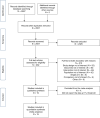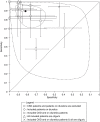Diagnostic Performance of Fractional Excretion of Sodium for the Differential Diagnosis of Acute Kidney Injury: A Systematic Review and Meta-Analysis
- PMID: 35545442
- PMCID: PMC9269645
- DOI: 10.2215/CJN.14561121
Diagnostic Performance of Fractional Excretion of Sodium for the Differential Diagnosis of Acute Kidney Injury: A Systematic Review and Meta-Analysis
Abstract
Background and objectives: AKI is classified as prerenal, intrinsic, and postrenal. Prerenal AKI and intrinsic AKI represent the most common causes for AKI in hospitalized patients. This study aimed to examine the accuracy of the fractional excretion of sodium for distinguishing intrinsic from prerenal AKI.
Design, setting, participants, & measurements: We searched MEDLINE, Embase, Cochrane Central Register of Controlled Trials, the Cochrane Library, and Scopus for all available studies that met the criteria until December 31, 2021. We included studies that evaluated fractional excretion of sodium in differentiating AKI etiologies in adults, whereas studies that did not have sufficient data to extract a 2×2 table were excluded. We assessed the methodologic quality using the Quality Assessment of Diagnostic Accuracy Studies-2 tool and extracted the diagnostic accuracy data for all included studies. We conducted a meta-analysis using the bivariate random effects model. We performed subgroup analysis to investigate sources of heterogeneity and the effect of the relevant confounders on fractional excretion of sodium accuracy.
Results: We included 19 studies with 1287 patients. In a subset of 15 studies (872 patients) that used a threshold of 1%, the pooled sensitivity and specificity for differentiating intrinsic from prerenal AKI were 90% (95% confidence interval, 81% to 95%) and 82% (95% confidence interval, 70% to 90%), respectively. In a subgroup of six studies (511 patients) that included CKD or patients on diuretics, the pooled sensitivity and specificity were 83% (95% confidence interval, 64% to 93%) and 66% (95% confidence interval, 51% to 78%), respectively. In five studies with 238 patients on diuretics, the pooled sensitivity and specificity were 80% (95% confidence interval, 69% to 87%) and 54% (95% confidence interval, 31% to 75%), respectively. In eight studies with 264 oliguric patients with no history of CKD or diuretic therapy, the pooled sensitivity and specificity were 95% (95% confidence interval, 82% to 99%) and 91% (95% confidence interval, 83% to 95%), respectively.
Conclusions: Fractional excretion of sodium has a limited role for AKI differentiation in patients with a history of CKD or those on diuretic therapy. It is most valuable when oliguria is present.
Keywords: AKI; DTA; FENa; meta-analysis; sodium; systematic review.
Copyright © 2022 by the American Society of Nephrology.
Figures




Comment in
-
Fractional Excretion of Sodium (FENa): An Imperfect Tool for a Flawed Question.Clin J Am Soc Nephrol. 2022 Jun;17(6):777-778. doi: 10.2215/CJN.04750422. Epub 2022 May 25. Clin J Am Soc Nephrol. 2022. PMID: 35613884 Free PMC article. No abstract available.
References
-
- Bellomo R, Ronco C, Kellum JA, Mehta RL, Palevsky P; Acute Dialysis Quality Initiative workgroup : Acute renal failure - Definition, outcome measures, animal models, fluid therapy and information technology needs: The Second International Consensus Conference of the Acute Dialysis Quality Initiative (ADQI) Group. Crit Care 8: R204–R212, 2004 - PMC - PubMed
-
- Kidney Disease Improving Global Outcomes (KDIGO) : Acute Kidney Injury (AKI). Available at: https://kdigo.org/guidelines/acute-kidney-injury/. Accessed August 28, 2021
-
- Pépin MN, Bouchard J, Legault L, Ethier J: Diagnostic performance of fractional excretion of urea and fractional excretion of sodium in the evaluations of patients with acute kidney injury with or without diuretic treatment. Am J Kidney Dis 50: 566–573, 2007 - PubMed
-
- Schrier RW: Need to intervene in established acute renal failure. J Am Soc Nephrol 15: 2756–2758, 2004 - PubMed
Publication types
MeSH terms
Substances
LinkOut - more resources
Full Text Sources
Other Literature Sources
Medical
Miscellaneous

